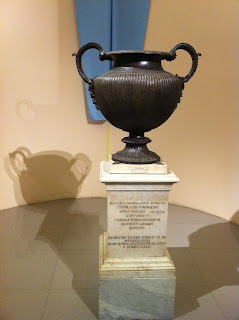 |
| Bronze krater of Mithradates the Great |
by Catherine Schofield Sezgin, ARCA Blog Editor-in-chief
A large bronze vase, crafted under Mithradates the Great of Pontus, was stolen from Asia Minor during one of the Mithradatic Wars by either Sulla or Pompey; displayed in the seaside villa of a Roman Emperor; and owned by a pope before it entered the collection of the Capitoline Museum in Rome. This summer it visited Amelia.
According to the Archaeological Museum in Amelia, the krater may have been a gift to a school, a gymnasium, on the Greek Island of Delos for the inhabitants' support of Mithradates, the Greco-Persian ruler from the Black Sea kingdom who expanded his territory into Anatolia and Asia Minor to protest the occupation of the Romans and their taxation policies. The krater was likely shaped to mix wine with water and honey, and linked to Dionysus -- it is likely that the original vessel loops were decorated with branches and brunches of grapes (Museo di arcaeologico, Amelia).
In 87 BC, Mithradates’ generals fought for Roman-controlled Delos. “The destruction was devastating: the city was sacked and burned to the ground,” Adrienne Mayor writes in The Poison King: The Life and Legend of Mithradates, Rome’s Deadliest Enemy (Princeton Press, 2009). “Thousands of able-bodied slaves, suddenly freed from Roman chains, joined the Greek liberation army. Mithradates’ generals killed virtually all the unarmed Italian merchants of Delos and sold their wives and children into slavery.”
On Delos, Mithradates’ generals looted the treasures from the great Temple of Apollo, then after storing most of the plunder on the island of Skiathos, moved the treasure to Aristion in Athens. The treasure was then used to finance Athens’ fight against Rome.
Mayor shows an image of this first century BC krater in The Poison King. “During the First Mithradatic War,” Mayor writes, “this krater was apparently plundered by Sulla and taken to Rome.” [Mayor sites her information from a book by Deniz Burcu Erciyas, Wealth, Aristocracy and Royal Propaganda under the Hellenistic Kingdom of the Mithradatids in the Central Black Sea Region of Turkey. Colloquia Pontica 12. Leiden: Brill).
Whilst Mayor figures Sulla took the krater from Athens, information posted from the Archaeological Museum in Amelia this summer claims it was Pompey the Great who brought the krater from Greece to Rome with the spoils of war after the defeat of Mithradates. Regardless, both of these men looted from Mithradates.
Lucius Cornelius Sulla was dispatched by Rome to avenge the 88 BC massacre of Romans and Italians instigated by Mithradates the Great. Unfortunately, as soon as he left Rome, the 50-year-old Sulla (the name meant “Pimples” and referred to his complexion) suffered an upset by a political rival who declared Sulla “Public Enemy of Rome” and cut off his supplies and funds for 30,000 men. Before he could reach the Province of Asia, Sulla landed in Greece and began demands for money and fought for supplies. He eventually, as Mayor writes in The Poison King, “seized the sacred treasures of Greece, plundering the temples of Zeus at Olympia and Asclepius in Epidaurus. Selecting the most beautiful, precious art for himself, he melted down massive amounts of silver to pay his men and buy supplies.” Sulla destroyed Athens and then went on to the Province of Asia to win the First Mithradatic War.
Pompey the Great won the third and last of the Mithradatic Wars. In late 65 BC, the victorious Pompey, searching for Mithradates who had crossed to safety over the Caucasus Mountains, seized fortresses and treasures in Pontus. “The vaults at Talaura yielded cups of onyx and gold, splendid furniture, bejeweled armor and gilded horse bridles, Persian antiques, and the treasure from Cos – including the precious cloak of Alexander the Great,” Mayor writes.
The krater eventually reached the Italian peninsula:
"Two hundred years later, the krater belonged to the emperor Nero, who kept it at his luxurious seaside villa at Antium," Mayor writes. "Unearthed from the villa’s ruins by Pope Benedict XIV in the eighteenth century, the bronze krater is now a centerpiece in Rome’s Capitoline Museum."
Nero Claudius Caesar Augustus Germanicus was the grandson of Germanicus whose bronze image ended up in Amelia’s archaeological museum.

Thank you for an excellent and informative article about the Mithradates Krater. But some questions come to mind. What is the evidence that the krater came from Delos? That was originally a purely sacred Greek island, with few residents except for priests, and so would not have had any gymnasia (colleges). By the lifetime of Mithradates, it had been taken over by Rome and turned into a huge slave market. The occupied Greeks residents at the time may have supported Mithradates, but would they have formed a gymnasion under the name Eupatoristai? The island was dominated by Romans. I think the scholars who say the krater was given to supporters in Athens are correct. I believe that the museum curators name Pompey as the plunderer because his loot from Mithradatic lands was more spectacular and famous than Sulla's. Pompey did not take plunder from Delos, but from cities in Anatolia. Note that on p 190 of Mayor's Poison King, Mithradates' generals overran Roman-held Delos in 88 BC, massacred the Italian population, and took all the treasures of Delos to the island of Skiathos--and from there all of the treasures were delivered to Athens. This evidence shows that even if the Krater was from Delos (unlikely), it would be Sulla, not Pompey, who plundered the Mithradates Krater from Athens.
ReplyDeleteAdrienne Mayor
One of the "Labels" for this article is a typo: it says Minneapolis Krater
ReplyDeleteinstead of Mithradates Krater
Thank you for the copy editing assistance!
ReplyDelete